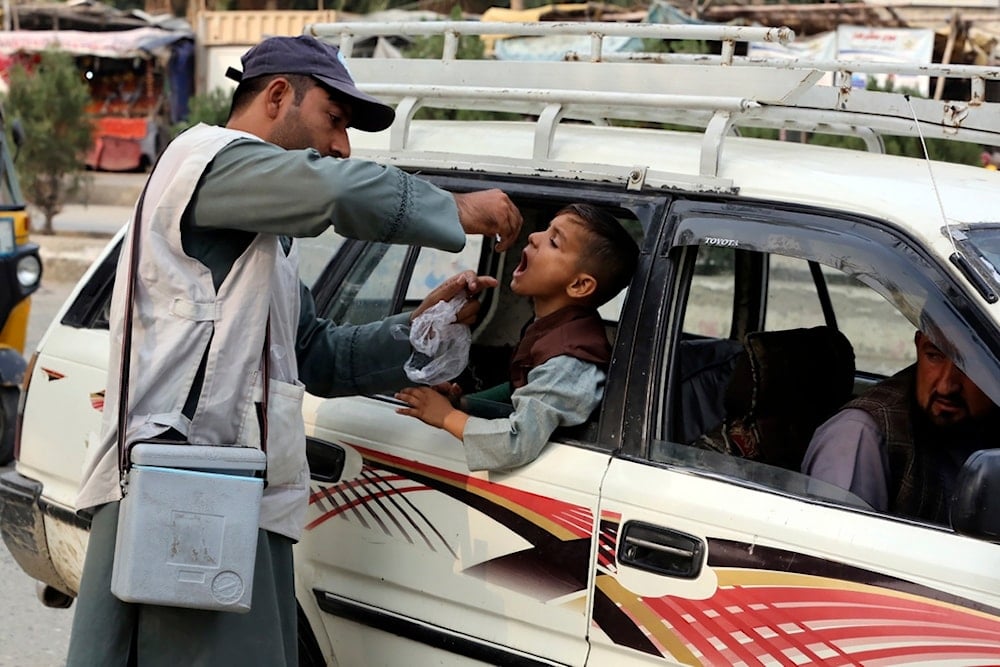Over 30% of Afghanistan's population lacks access to health services
Afghan Deputy Prime Minister Abdul Salam Hanafi expresses concerns over the distribution of expired medicines and substandard medical equipment by international organizations.
-

A health worker administers a polio vaccine to a child inside a Taxi in the city of Jalalabad, east of Kabul, Afghanistan, Tuesday, October 29, 2024 (AP)
A significant portion of Afghanistan’s population—approximately one-third—does not have access to essential health services, according to Edwin Ceniza Salvador, the World Health Organization (WHO) Representative and Head of Mission in Afghanistan.
"About 67% of the population currently has access, which means that about 33% of the population do not have access to the health services," Salvador stated, as quoted by Afghan broadcaster Tolo News on Tuesday.
"And these are, like I mentioned, most people in the rural areas and most that are geographically difficult to access in winter seasons," he highlighted.
Salvador indicated that funding shortages forced the WHO to withdraw support from numerous medical facilities, resulting in the closure of 226 centers.
He also noted the exodus of many Afghan doctors following the Taliban's ascent to power in August 2021, as Afghanistan has fallen under heavy international sanctions amid global recognition of the new government.
Despite these challenges, Salvador emphasized the WHO’s ongoing efforts to train skilled midwives and the urgent need to support healthcare workers, particularly female doctors and nurses, throughout Afghanistan.
Meanwhile, Afghan Deputy Prime Minister Abdul Salam Hanafi expressed concerns over the distribution of expired medicines and substandard medical equipment by international organizations.
According to the broadcaster, WHO Regional Director for the Eastern Mediterranean, Hanan al-Balkhi, pledged to investigate the matter.
Hanafi also urged the WHO to address critical issues, including facilitating visa issuance for Afghan patients, improving treatment options for drug addicts and those with infectious diseases, establishing a specialized oncology hospital, and resuming polio laboratory operations, the report added.
Foreign occupation reason for most of Kabul's problems
The last US soldier left the Afghan capital on August 31, 2021, marking the end of nearly 20 years of NATO-led brutal occupation, which led to never-ending costs of lives and dollars. Some 66,000 Afghan troops and 48,000 civilians were killed during that period.
Following the US withdrawal from Afghanistan, the country has faced a severe humanitarian crisis characterized by economic collapse and widespread food insecurity.
The abrupt cessation of international aid, which previously accounted for approximately 75% of Afghanistan's public expenditures, led to a rapid economic downturn. This decline resulted in widespread unemployment and a sharp increase in poverty levels.
Consequently, millions of Afghans have struggled to meet basic needs, with acute malnutrition becoming a pervasive issue across the nation.
After the Taliban's takeover, approximately $7 billion in Afghan central bank reserves held in the United States were frozen. Other countries also froze Afghan assets in their banking systems.
While some of these funds have been allocated to humanitarian efforts, the bulk remains inaccessible to the Taliban government, limiting Afghanistan’s ability to stabilize its economy or invest in development projects.
Moreover, sanctions imposed on the Taliban restrict Afghanistan's access to the global financial system, making it difficult to conduct trade or secure international investments.
Though the humanitarian crisis persists, with millions still in need of aid, the international community continues to grapple with the challenge of delivering assistance that alleviates suffering without empowering the Taliban.
Read more: Afghanistan asks Russia for help in rebuilding country

 3 Min Read
3 Min Read








